science

How do floors and distance affect purchases?
Consumers who stand on carpeted flooring feel comforted, but they judge products close to them to be less comforting, according to a new study in the Journal of Consumer Research.
{ EurekAlert | Continue reading }
economics, science | November 19th, 2009 6:32 pm
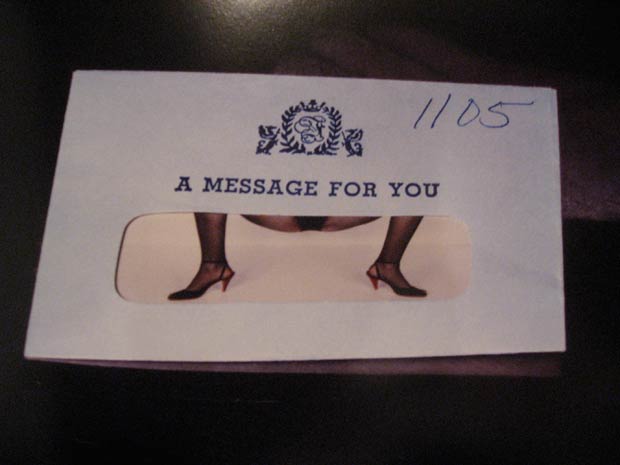
When it comes to creativity, it’s easy to imagine that more is better. Creativity lies at the heart of science. It solves problems and drives innovation. Then there’s the small matter of art and literature. Humanity’s self expression and aesthetic explorations are born of our creative drive.
And yet creativity has its downsides too, say Stefan Leijnen and Liane Gabora at the University of British Columbia in Canada. Creative solutions can only spread if they are adopted by other individuals. These imitators play an important role in society. They act as a kind of memory, storing the results of successful creative strategies for future generations. But the time that individuals spend creating means less time imitating. Clearly we cannot all be creators all the time but neither can we all be imitators.
That raises an interesting question, say Leijnen and Gabora. How much creativity does a society need to optimize the evolution of ideas?
To find out, they built a computational model that simulates the way ideas are created, how they spread and how they evolve in a society.
{ The Physics arXiv Blog | Continue reading }
photo { Guy Bourdin }
ideas, science | November 19th, 2009 6:29 pm
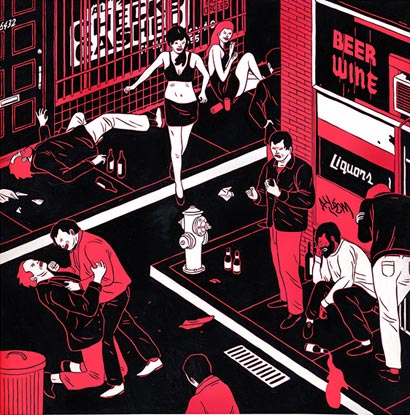
Laboratory experiments in psychology find that media violence increases aggression in the short run. We analyze whether media violence affects violent crime in the field.
We exploit variation in the violence of blockbuster movies from 1995 to 2004, and study the effect on same-day assaults.
We find that violent crime decreases on days with larger theater audiences for violent movies. The effect is partly due to voluntary incapacitation: between 6PM and 12AM, a one million increase in the audience for violent movies reduces violent crime by 1.1 to 1.3 percent. After exposure to the movie, between 12AM and 6AM, violent crime is reduced by an even larger percent. This finding is explained by the self-selection of violent individuals into violent movie attendance, leading to a substitution away from more volatile activities. In particular, movie attendance appears to reduce alcohol consumption. (…)
Exposure to violent movies has three main effects on violent crime: (i) it reduces significantly violent crime in the evening on the day of exposure; (ii) by an even larger percent, it reduces violent crime during the night hours following exposure; (iii) it has no significant impact in the days and weeks following the exposure.
{ Does movie violence increase violent crime?, Gordon Dahl and Stefano DellaVigna, 2008 |PDF | Continue reading }
illustration { Cleon Peterson }
science, showbiz | November 19th, 2009 6:28 pm
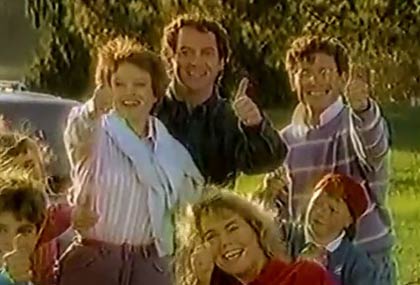
How would you fancy a holiday to Greece or Thailand? Would you like to buy an iPhone or a new pair of shoes? Would you be keen to accept that enticing job offer? Our lives are riddled with choices that force us to imagine our future state of mind. The decisions we make hinge upon this act of time travel and a new study suggests that our mental simulations of our future happiness are strongly affected by the chemical dopamine.
Dopamine is a neurotransmitter, a chemical that carries signals within the brain. Among its many duties is a crucial role in signalling the feelings of enjoyment we get out of life’s pleasures. We need it to learn which experiences are rewarding and to actively seek them out. And it seems that we also depend on it when we imagine the future.
Tali Sharot from University College London found that if volunteers had more dopamine in their brains as they thought about events in their future, they would imagine those events to be more gratifying. It’s the first direct evidence that dopamine influences how happy we expect ourselves to be.
When we learn about new experiences, neurons that secrete dopamine seem to record the difference between the rewards we expect and the ones we actually receive. In encoding the gap between hope and experience, these neurons help us to repeat rewarding actions.
{ Not Exactly Rocket Science/ScienceBlogs | Continue reading }
brain, science | November 19th, 2009 6:28 pm

So let’s look at Twitter in the context of Abraham Maslow’s concept of a hierarchy of needs, first presented in his 1943 paper “A Theory of Human Motivation.”
Maslow’s hierarchy of needs is most often displayed as a pyramid, with lowest levels of the pyramid made up of the most basic needs and more complex needs are at the top of the pyramid. Needs at the bottom of the pyramid are basic physical requirements including the need for food, water, sleep and warmth. Once these lower-level needs have been met, people can move on to higher levels of needs, which become increasingly psychological and social. Soon, the need for love, friendship and intimacy become important. Further up the pyramid, the need for personal esteem and feelings of accomplishment become important. Finally, Maslow emphasized the importance of self-actualization, which is a process of growing and developing as a person to achieve individual potential.
Twitter aims primarily at social needs, like those for belonging, love, and affection. Relationships such as friendships, romantic attachments and families help fulfill this need for companionship and acceptance, as does involvement in social, community or religious groups. Clearly, feeling connected to people via Twitter helps to fulfill some of this need to belong and feel cared about.
An even higher level of need, related to self-esteem and social recognition, is also leveraged by Twitter.
{ PsychologyToday | Continue reading }
photo { Juliane Eirich }
psychology, technology | November 19th, 2009 6:27 pm

You’ve heard of Neuromarketing, which measures the neural activity of consumers (via fMRI or EEG) in response to various products or advertisements. Now, get ready for Genomarketing!
The Neuroethics & Law Blog has alerted us to a recent paper by De Neve and Fowler (2009) reporting that people with a specific low efficiency variant of the gene for monoamine oxidase A are significantly more likely to have credit card debt. (…)
Using data from the National Longitudinal Study of Adolescent Health, the authors found in that sample of 18-26 year olds,
Having one or both MAOA alleles of the low efficiency type raises the average likelihood of having credit card debt by 7.8% and 15.9% respectively. (…)
Is this the foreshadowing of a highly unethical marketing practice? Marketing based on MAO-A genotype, as determined from mailed-in credit card applications and payments? Credit card companies will have in-house labs to extract DNA from stamps and envelope flaps (Sinclair & McKechnie, 2000; Ng et al., 2007). Taking it one step further, entire marketing campaigns will be tailored to specific markers in an individual’s genome.
Not so fast. There are many limitations in the findings of De Neve and Fowler.
{ The Neurocritic | Continue reading }
neon { Martin Creed | Thanks Daniel! }
economics, marketing, science | November 19th, 2009 6:27 pm
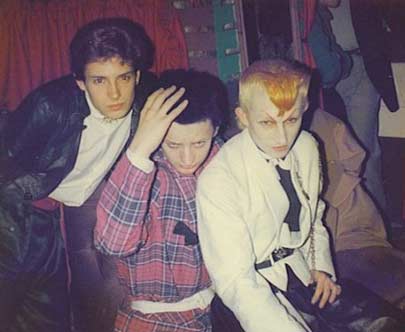
The pride expression is a fairly specific signal of high status. (…) The pride display may be best viewed as a gestalt signal in which the sum of various parts (expanded body posture, small smile, head tilt back, arms extended) transmits an automatically interpreted message. (…)
Pride expression sends a message that is distinct from that of happiness, consistent with a growing body of research suggesting that distinct positive emotions, such as pride and happiness, may have evolved to serve distinct functions. (…)
The high-status signal sent by pride expression also appears to be distinct from any message sent by anger. Previous research has shown that displays of anger lead observers to judge individuals as more professionally qualified than individuals displaying sadness. Thus, anger seems to convey a sense of power or competence, at least relative to a low-power (and presumably low-status) emotion such as sadness. Yet, the present findings suggest that the anger expression does not convey high status to the same extent as pride; in fact, when compared with pride, anger was relatively more associated with low status. (…)
The current results demonstrate that high-status perceptions of the pride expression are unelaborated and automatic. Indeed, this is the first research to suggest that our ability to rapidly and involuntarily assess social status may be due, in part, to our ability to automatically recognize and interpret displays of pride.
{ Azim F. Shariff and Jessica L. Tracy, Knowing Who’s Boss: Implicit Perceptions of Status From the Nonverbal Expression of Pride, 2009 | PDF | Continue reading | via OvercomingBias }
ideas, psychology, science | November 13th, 2009 9:46 am

For all its tumult — erupting stars, colliding galaxies, collapsing black holes — the cosmos is a surprisingly orderly place. Theoretical calculations have long shown that the entropy of the universe — a measure of its disorder — is but a tiny fraction of the maximum allowable amount.
A new calculation of entropy upholds that general result but suggests that the universe is messier than scientists had thought — and slightly further along on its gradual journey to death, two Australian cosmologists conclude. (…) Tthe collective entropy of all the supermassive black holes at the centers of galaxies is about 100 times higher than previously calculated. Because supermassive black holes are the largest contributor to cosmic entropy, the finding suggests that the entropy of the universe is also about 100 times larger than previous estimates.
Entropy quantifies the number of different microscopic states that a physical system can have while looking the same on a large scale. For instance, an omelet has higher entropy than an egg because there are more ways for the molecules of an omelet to rearrange themselves and still remain an omelet than for an egg, notes cosmologist Sean Carroll of the California Institute of Technology in Pasadena.
A black hole is the entropy champ because there are myriad ways for all the material that has fallen into it to be arranged microscopically while the black hole retains the same numerical values for its observable properties — charge, mass and spin.
{ ScienceNews | Continue reading }
This world is arranged as it had to be if it were to be capable of continuing with great difficulty to exist; if it were a little worse, it would be no longer capable of continuing to exist. Consequently, since a worse world could not continue to exist, it is absolutely impossible; and so this world itself is the worst of all possible worlds.
{ Schopenhauer, The World as Will and Representation, II, 46, 1818 }
artwork { Georgia O’Keeffe, Abstraction Blue, 1927 }
ideas, science, space | November 13th, 2009 9:45 am

Orchidaceae, the Orchid family, is the largest family of the flowering plants.
The Royal Botanical Gardens of Kew list 880 genera and nearly 22,000 accepted species, but the exact number is unknown (perhaps as many as 25,000) because of taxonomic disputes.
The number of orchid species equals about four times the number of mammal species, or more than twice the number of bird species. It also encompasses about 6–11% of all seed plants.
About 800 new orchid species are added each year.
{ Wikipedia | Continue reading }
Most of us have genes that make us as hardy as dandelions: able to take root and survive almost anywhere. A few of us, however, are more like the orchid: fragile and fickle, but capable of blooming spectacularly if given greenhouse care. So holds a provocative new theory of genetics, which asserts that the very genes that give us the most trouble as a species, causing behaviors that are self-destructive and antisocial, also underlie humankind’s phenomenal adaptability and evolutionary success. With a bad environment and poor parenting, orchid children can end up depressed, drug-addicted, or in jail—but with the right environment and good parenting, they can grow up to be society’s most creative, successful, and happy people.
{ The Atlantic | Continue reading }
related { Japanese researchers extract vanilla from cow dung. }
illustration { Octavio Ocampo }
Botany, food, drinks, restaurants, ideas | November 13th, 2009 9:42 am

Greene and Paxton had hypothesized that if deciding to be honest is a conscious process—the result of resisting temptation—the areas of the brain associated with self-control and critical thinking would light up when subjects told the truth. If it is automatic, those areas would remain dark.
What they found is that honesty is an automatic process—but only for some people.
{ Seed magazine | Continue reading }
artwork { Alexander Calder, Big Red, 1959 | Sheet metal and steel wire }
psychology | November 13th, 2009 9:40 am

The catastrophic decline around the world of “apex” predators such as wolves, cougars, lions or sharks has led to a huge increase in smaller “mesopredators” that are causing major economic and ecological disruptions, a new study concludes.
The findings, published today in the journal Bioscience, found that in North America all of the largest terrestrial predators have been in decline during the past 200 years while the ranges of 60 percent of mesopredators have expanded. The problem is global, growing and severe, scientists say, with few solutions in sight.
An example: in parts of Sub-Saharan Africa, lion and leopard populations have been decimated, allowing a surge in the “mesopredator” population next down the line, baboons. In some cases children are now being kept home from school to guard family gardens from brazen packs of crop-raiding baboons. (…)
Primary or apex predators can actually benefit prey populations by suppressing smaller predators, and failure to consider this mechanism has triggered collapses of entire ecosystems.
{ EurekAlert | Continue reading }
animals, incidents, science | November 13th, 2009 9:34 am
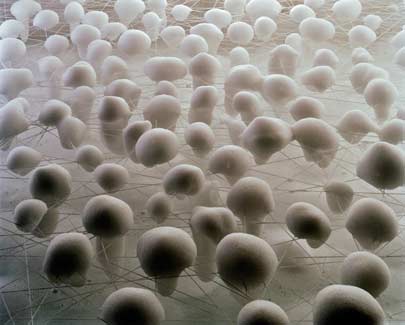
We all naturally think that our perception of the external world is accurate and correct: why else would it work so consistently for us? By and large, that view is quite correct. The model we have of the world works because our brains constantly make predictions about how the world behaves and when we test it by our actions, the errors are detected and the model is improved. This correction means that we are always improving our model of the physical world, making it more useful.
Chris Frith, a Professor of Neuropsychology, explains how our brain filters out a vast amount of what we perceive. Our vision is constantly corrected by the brain to allow for everything from indistinct features on the edge of our field of view, through to filling in the blind spot on our retinas so we see complete scenes. Our brain routinely compensates for inadequate perception by filling in the details by prediction.
{ Blogcritics | Continue reading }
photo { Cassander Eeftinck Schattenkerk }
related { How your brain creates the fourth dimension. }
brain, science | November 13th, 2009 9:32 am

The ability to digest the milk sugar lactose first evolved in dairy farming communities in central Europe, not in more northern groups as was previously thought, finds a new study led by UCL (University College London) scientists published in the journal PLoS Computational Biology. The genetic change that enabled early Europeans to drink milk without getting sick has been mapped to dairying farmers who lived around 7,500 years ago in a region between the central Balkans and central Europe. Previously, it was thought that natural selection favoured milk drinkers only in more northern regions because of their greater need for vitamin D in their diet. People living in most parts of the world make vitamin D when sunlight hits the skin, but in northern latitudes there isn’t enough sunlight to do this for most of the year.
In the collaborative study, the team used a computer simulation model to explore the spread of lactase persistence, dairy farming, other food gathering practices and genes in Europe. The model integrated genetic and archaeological data using newly developed statistical approaches.
{ EurekAlert | Continue reading }
flashback, food, drinks, restaurants, science | November 13th, 2009 9:32 am
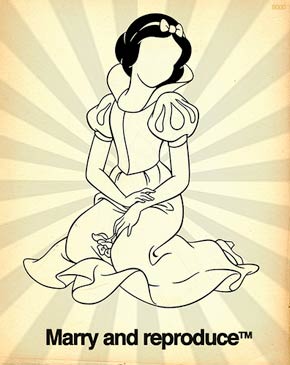
Researchers at the Swedish medical university Karolinska Institutet have discovered a mechanism that controls the brain’s ability to create lasting memories. In experiments on genetically manipulated mice, they were able to switch on and off the animals’ ability to form lasting memories by adding a substance to their drinking water.
The ability to convert new sensory impressions into lasting memories in the brain is the basis for all learning. Much is known about the first steps of this process, those that lead to memories lasting a few hours, whereby altered signalling between neurons causes a series of chemical changes in the connections between nerve fibers, called synapses. However, less is understood about how the chemical changes in the synapses are converted into lasting memories stored in the cerebral cortex.
A research team at Karolinska Institutet has now discovered that signalling via a receptor molecule called nogo receptor 1 (NgR1) in the nerve membrane plays a key part in this process.
{ Karolinska Institutet | Continue reading }
related { Traumatic memories can be erased. }
brain, science | November 13th, 2009 9:30 am

Pica is a medical disorder characterized by an appetite for substances largely non-nutritive (e.g., clay, coal, soil, feces, chalk, paper, soap, mucus, ash, gum etc.) or an abnormal appetite for some things that may be considered foods, such as food ingredients (e.g., flour, raw potato, raw rice, starch, ice cubes, salt).
In order for these actions to be considered pica, they must persist for more than one month at an age where eating such objects is considered developmentally inappropriate. The condition’s name comes from the Latin word for magpie, a bird which is reputed to eat almost anything.
{ Wikipedia | Continue reading }
food, drinks, restaurants, gross, psychology | November 13th, 2009 9:30 am

{ Babies with an accent. Newborns cry differently depending on their mother tongue. | Max Planck Society | Full article }
related { Babies’ language learning starts from the womb }
kids, science | November 7th, 2009 3:44 pm

If philosophy hadn’t existed – apart from Aristotle – what would we not know? The answer is that it wouldn’t have made the slightest difference. (…)
Science has done very well without any philosophy whatsoever. Take biology over the last 100 years – philosophy has had zero impact. (…)
Nothing in Popper or in any other philosophy of science has anything relevant to say about science.
{ Lewis Wolpert/The Philosophers’ Magazine | Continue reading }
For example, what does quantum mechanics actually mean? I’ve been using quantum mechanics for about 35 years, almost three-quarters of my life, and the more I study it the less I understand it.
{ Alan Sokal/The Philosophers’ Magazine | Continue reading }
ideas, science | November 7th, 2009 3:37 pm

You’re sitting at home and you see an ad on TV for junk food. Fast food, some sugary cereal, a hot dog wrapped in a waffle wrapped in bacon wrapped in whale blubber. Whatever. Even if you don’t go out and buy this product, can the ad itself contribute to making you fat?
It can.
That’s the conclusion of a new paper out in Health Psychology:
Children consumed 45% more when exposed to food advertising. Adults consumed more of both healthy and unhealthy snack foods following exposure to snack food advertising…
{ True/Slant | Continue reading }
related { Weird food McDonald’s sells around the world. }
related { We spend more on products with detailed nutritional information. }
food, drinks, restaurants, marketing, science | November 7th, 2009 3:30 pm

Humanity has long struggled over the nature of time. In the last century, physicists were shocked to discover that the arrow of time cannot be derived from the laws of physics which appear perfectly symmetric. For every solution for t, there seems to be an equally valid solution for -t (except in a few cases involving the weak force in which case the symmetry is more complex, involving charge, parity and time).
At first glance that looks puzzling. But after a few years reflection, most physicists agreed that it’s perfectly possible for symmetric laws to give rise to asymmetric phenomena. Physicists have identified a number of such asymmetric phenomena that represent “arrows of time”, says Claus Kiefer at the Institut fur Theoretische Physik in Cologne, Germany.
Perhaps the most famous is the thermodynamic arrow of time in which the entropy of a closed system must always increase. But there is also a quantum mechanical arrow of time in which a preferred direction of time is determined by decoherence and a gravitational arrow of time in which the preferred direction is determined by gravitational collapse.
“What is peculiar is the fact that the time direction of the phenomena is always the same,” says Kiefer. It’s almost as if the arrow of time were predetermined in some way. “The question raised by the presence of all these arrows is whether a common master arrow of time is behind all of them,” he asks.
What master law might be responsible? Kiefer’s conjecture is that the direction of time arises when quantum mechanics is applied to the universe as a whole, a branch of science known as quantum cosmology.
{ The Physics arXiv Blog | Continue reading }
In the natural sciences, arrow of time, or time’s arrow, is a term coined in 1927 by British astronomer Arthur Eddington used to distinguish a direction of time on a four-dimensional relativistic map of the world, which, according to Eddington, can be determined by a study of organizations of atoms, molecules, and bodies.
Physical processes at the microscopic level are believed to be either entirely or mostly time symmetric, meaning that the theoretical statements that describe them remain true if the direction of time is reversed; yet when we describe things at the macroscopic level it often appears that this is not the case: there is an obvious direction (or flow) of time. An arrow of time is anything that exhibits such time-asymmetry.
The symmetry of time (T-symmetry) can be understood by a simple analogy: if time were perfectly symmetric then it would be possible to watch a movie taken of real events and everything that happens in the movie would seem realistic whether it was played forwards or backwards.
An obvious objection to this assertion is gravity: after all, things fall down, not up.
{ Wikipedia | Continue reading }
science, time | November 7th, 2009 3:26 pm
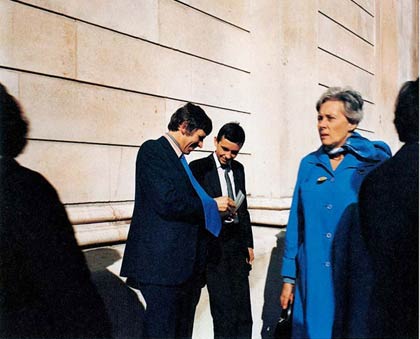
What’s the gossip in your office? What’s the gossip doing to your office? And what are the best strategies for gossips or antigossips to employ in the office? (…)
Timothy Hallett, a sociologist at Indiana University, spent two years studying the institutional politics at an elementary school in a Midwestern city. During that time, Dr. Hallett videotaped formal meetings among a group of teachers who convened regularly to discuss problems and policies.
The teachers would occasionally start to deviate from the official agenda and discuss their feelings about the administrators, particularly the principal, who was disliked for her style and her effort to impose more “accountability” on the teachers. These “gossip episodes” are analyzed by Dr. Hallett and his co-authors. (…) “Gossip was a ‘weapon of the weak’: during a time in which teachers were disenfranchised, gossip empowered them and served to stigmatize Kox.”
{ TierneyLab/NY Times | Continue reading }
“Office gossip can be a form of reputational warfare,” Dr. Hallett says. “It’s like informal gossip, but it’s richer and more elaborate. There are more layers to it because people practice indirectness and avoidance. People are more cautious because they know they can lose not just a friendship but a job.”
During his two years studying the group dynamics at a Midwestern elementary school, which allowed him access on condition of anonymity, Dr. Hallett found that the teachers became so comfortable with him and his camera that they would freely insult their bosses during one-on-one interviews. But at the teachers’ formal group meetings, where they knew that another teacher might report their insults to the principal, they were more discreet.
Instead of making direct criticisms, they sometimes offered obliquely sarcastic comments to test the waters. They used another indirect tactic categorized as praise the predecessor, as in the meeting when a teacher fondly recalled a previous administration: “It was so calm, and you could teach. No one was constantly looking over your shoulder.” The other teachers quickly agreed. No one explicitly called the current principal an authoritarian busybody, but that was the obvious implication.
{ NY Times | Continue reading }
photo { Paul Graham }
relationships, science | November 7th, 2009 3:21 pm






















